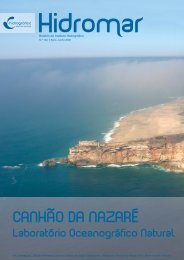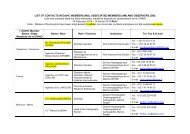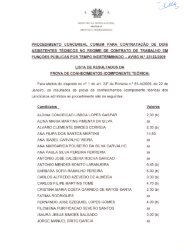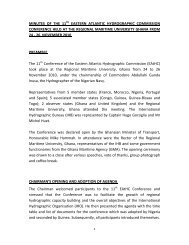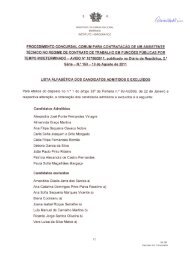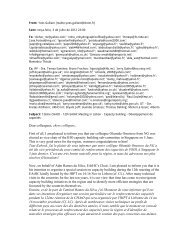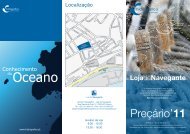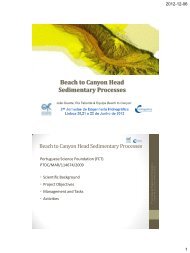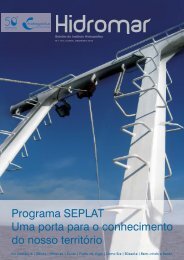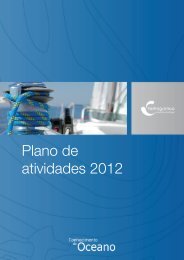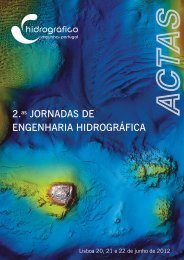Create successful ePaper yourself
Turn your PDF publications into a flip-book with our unique Google optimized e-Paper software.
66 ANAIS DO INSTITUTO HIDROGRÁFICO N.º 15<br />
1. Introduction<br />
Areal time evaluation of the nearshore wave conditions<br />
is of essential importance in ocean engineering<br />
applications for the safe design and<br />
exploitation of marine structures and installations as<br />
well as for various military operations. For this reason<br />
in the last years were developed almost all over the<br />
world advanced wave prediction programs emphasizing<br />
on the improvement of the wave data assessment in the<br />
littoral regions and in the surf zones, where is dissipated<br />
most of the wave energy. Developing of wave coastal<br />
models and interacting of global and regional scale<br />
models with high resolution wave models it is still one<br />
of the greatest priorities of these programs. Such high<br />
resolution models are likely to be run to surface areas<br />
not more than 50km by 50km and the predictions may<br />
be significantly improved by infusion of strategically<br />
placed ‘in situ’ collected or remotely sensed data. In<br />
shallow water, near the coast, the spectral phased averaged<br />
models (as SWAN and HISWA appear also to offer<br />
additional capabilities to the Navy especially for the<br />
interpretation of the remote sensing data.<br />
However, the general research in this area was<br />
focussed up to now mainly in incorporating into the<br />
models the effects of the large-scale global currents and<br />
in improving the nonlinear source terms, for developing<br />
more accurate algorithms. For this reason there is still<br />
a strong need of new and more efficient computational<br />
environments to perform an adequate processing of the<br />
data, either before or after the model simulation. In this<br />
perspective coupling the wave models with easy to use<br />
pre and post processing tools should be considered as<br />
subjects of prime interest in the field of the wave data<br />
assimilation techniques.<br />
2. The metho<strong>do</strong>logy proposed<br />
As a reference point, for the metho<strong>do</strong>logy proposed<br />
here, was used the SWAN spectral model. However the<br />
new developed computational environment could be<br />
useful and easily adapted to the most of the existent<br />
wave models. SWAN is a high resolution numerical wave<br />
model designed to obtain realistic estimates of wave<br />
parameters in coastal areas, lakes and estuaries from<br />
given wind, bottom, and current conditions. The model<br />
is based on the action balance equation (or energy<br />
balance in the absence of currents) with sources and<br />
sinks. The SWAN model has been developed at the Delft<br />
University of Technology, Department of Civil Engineering,<br />
Delft, the Netherlands, [Ris et al (1998)]. It was<br />
released in the public <strong>do</strong>main and can be <strong>do</strong>wnloaded<br />
from the Internet. In SWAN the following wave propagation<br />
processes are implemented: propagation through<br />
geographic space, refraction due to bottom and current<br />
variations, shoaling due to bottom and current variations,<br />
blocking and reflections by opposing currents,<br />
transmission through or blockage by obstacles. It also<br />
accounts for the dissipation effects due to whitecapping,<br />
bottom friction and wave breaking. The depth and<br />
currents (if present) are input to SWAN. The first implementation<br />
of the SWAN model in Portugal was made by<br />
the ‘<strong>Instituto</strong> Hidrografico’ of the Portuguese Navy in<br />
the context of the project PAMMELA. Initially were<br />
performed simulations in the area Pinheiro da Cruz,<br />
south of Lisbon and nearby Setubal, the implementation<br />
of the model being extended now also to some other<br />
areas from the Portuguese nearshore.<br />
BARCO is the acronym of BAthymetry Reshape and<br />
COnfigure and it is an original computation program<br />
developed using the MATLAB environment. Its functions<br />
are to assess bathymetries and isolines, to plot<br />
maps and isomaps and to reshape grids. All these operations<br />
can be made before, while or after the wave model<br />
is run. As input this model uses exactly the same type of<br />
files with the bathymetric data as the SWAN wave<br />
model.<br />
TOTAL WAVE is a post-processing interface that makes<br />
available wave conditions in the nearshore and surf<br />
zone, in a user-friendly way. The wave data propagation<br />
and transform from the source to the end user can be<br />
seen in figure 1, where is suggested also the main idea<br />
which is behind the proposed treatment of the data.<br />
That is some of the computational effort is taken from<br />
the wave model by the pre-processing tool and is created<br />
in this way a direct link between the stages of pre and<br />
post-processing.<br />
In order to point the advantages introduced by this<br />
new interactive computational environment it is may be<br />
better to enlarge the explanation of the procedure<br />
proposed here (figure 1). First a general and easy to use<br />
tool for assessing the bathymetric configuration developed<br />
in the same environment (Matlab) as the postprocessing<br />
tool, should be very useful before running<br />
the model in the process of setting the most appropriate<br />
area where the model is going to be run. Moreover in<br />
the case of the nested runs its utility is even greater<br />
because BARCO has the possibility of reshaping grids,<br />
defining a sub-<strong>do</strong>main in the input area and working<br />
simultaneously in different frames with both the initial<br />
and the final area. Another reason is that the computational<br />
time of the most of the wave models strongly<br />
depends of the number of the output requests and<br />
consequently all the computations that are made<br />
outside the model have as a result a significant decreasing<br />
of the computational time of the model itself. May<br />
be it is also worth mentioning here that the programs<br />
‘BARCO’ and TOTAL WAVE work in a real time and their



